Infant airway diameter - Study guides, Class notes & Summaries
Looking for the best study guides, study notes and summaries about Infant airway diameter? On this page you'll find 1404 study documents about Infant airway diameter.
Page 3 out of 1.404 results
Sort by
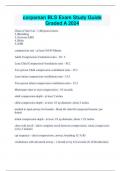
-
corpsman BLS Exam Study Guide Graded A 2024
- Exam (elaborations) • 3 pages • 2024
-
Available in package deal
-
- $12.49
- + learn more
Chain of Survival - 1.)Responsiveness 2.)Breathing 3.)Activate EMS 4.)Pulse 5.)CPR compression rate - at least 100 P/ Minute Adult Compression-Ventilation ratio - 30 : 2 Lone Child Compression-Ventilation ratio - 30:2 Two person Child compression-ventillation ratio - 15:2 Lone infant compression-ventillation ratio - 15:2 Two person infant compression-ventillation ratio - 15:2 Minimume time to start compressions - 10 seconds adult compression depth - at least 2 inches ...
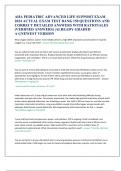
-
AHA PEDIATRIC ADVANCED LIFE SUPPORT EXAM 2024 ACTUAL EXAM TEST BANK 150 QUESTIONS AND CORRECT DETAILED ANSWERS WITH RATIONALES (VERIFIED ANSWERS) |ALREADY GRADED A+||NEWEST VERSION
- Exam (elaborations) • 26 pages • 2024
-
- $15.49
- + learn more
AHA PEDIATRIC ADVANCED LIFE SUPPORT EXAM 2024 ACTUAL EXAM TEST BANK 150 QUESTIONS AND CORRECT DETAILED ANSWERS WITH RATIONALES (VERIFIED ANSWERS) |ALREADY GRADED A+||NEWEST VERSION. What oxygen delivery system most reliably delivers a high (90% of greater) concentration of inspired oxygen to a 7-year-old child? - answer-Nonrebreathing face mask You are called to help treat an infant with severe symptomatic bradycardia (heart rate 66/min) associated with respiratory distress. Bradycardia pe...
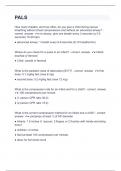
-
PALS Question and answers 100% correct
- Exam (elaborations) • 6 pages • 2024
-
Available in package deal
-
- $13.49
- + learn more
PALS Question and answers 100% correct PALS How many breaths, and how often, do you give a child during rescue breathing without chest compressions and without an advanced airway? - correct answer ● no airway: give one breath every 3 seconds (q 3-5 seconds) 15-20 bpm ● advanced airway: 1 breath every 6-8 seconds (8-10 breaths/min) Where do you check for a pulse in an infant? - correct answer ● Infant: brachial or femoral ● Child: carotid or femoral What is the pediatric do...
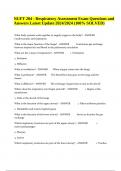
-
NUFT 204 - Respiratory Assessment Exam Questions and Answers Latest Update 2024/2025 (100% SOLVED)
- Exam (elaborations) • 25 pages • 2024
-
- $15.49
- + learn more
NUFT 204 - Respiratory Assessment Exam Questions and Answers Latest Update 2024/2025 (100% SOLVED) What body systems work together to supply oxygen to the body? - ANSWER Cardiovascular and respiratory What is the major function of the lungs? - ANSWER Continuous gas exchange between inspired air and blood in the pulmonary circulation What are the 3 steps of respiration? - ANSWER 1. Ventilation 2. Perfusion 3. Diffusion What is ventilation? - ANSWER When oxygen comes into the lungs What is...
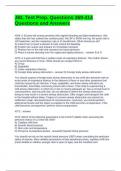
-
JBL Test Prep. Questions 369-414 Questions and Answers
- Exam (elaborations) • 12 pages • 2024
-
Available in package deal
-
- $14.99
- + learn more
JBL Test Prep. Questions 369-414 Questions and Answers #369: A 30-year-old woman presents with vaginal bleeding and light-headedness. She states that she has soaked four sanitary pads. Her BP is 90/50 mm Hg, her pulse rate is 120 beats/min, and her respiratory rate is 24 breaths/min. What should you do? A) Instruct her to insert a tampon to help control the bleeding. B) Position her supine and prepare for immediate transport. C) Position her on her side and reassess her blood pressure. D) P...
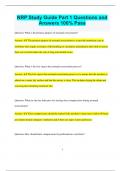
-
NRP Study Guide Part 1 Questions and Answers 100% Pass
- Exam (elaborations) • 9 pages • 2024
-
Available in package deal
-
- $9.99
- + learn more
NRP Study Guide Part 1 Questions and Answers 100% Pass Question: What is the primary purpose of neonatal resuscitation? Answer: The primary purpose of neonatal resuscitation is to provide immediate care to newborns who require assistance with breathing or circulation immediately after birth to ensure their survival and reduce the risk of long-term health issues. Question: What is the first step in the neonatal resuscitation process? Answer: The first step in the neonatal resuscita...

-
FDNY EMS FINAL EXAM Part 2 questions and answers
- Exam (elaborations) • 8 pages • 2024
- Available in package deal
-
- $13.99
- + learn more
FDNY EMS FINAL EXAM Part 2 questions and answers Cardiogenic shock - ANSWERS Caused by inadequate function of the heart or pump failure Edema - ANSWERS Fluid accumulation between cells in body tissues, causing swelling Preload - ANSWERS Volume of blood coming to the heart increases, the precontraction pressure in the heart builds up Afterload - ANSWERS The force or resistance against which the heart pumps. Obstructive shock - ANSWERS Shock that occurs when there is a block to blood ...
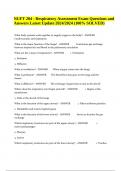
-
NUFT 204 Respiratory Assessment Questions and Answers Update 2024/2024 (100% SOLVED)
- Exam (elaborations) • 25 pages • 2024
-
Available in package deal
-
- $16.49
- + learn more
NUFT 204 Respiratory Assessment Questions and Answers Update 2024/2024 (100% SOLVED) What are the 3 steps of respiration? - ANSWER 1. Ventilation 2. Perfusion 3. Diffusion What is ventilation? - ANSWER When oxygen comes into the lungs What is perfusion? - ANSWER The blood flow that goes to the lungs and the tissues What is diffusion? - ANSWER The exchange of gases that occurs in the alveoli Where does the respiratory tract begin and end? - ANSWER 1. Begins at the mouth/nose 2. Ends at t...
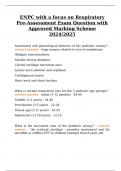
-
ENPC with a focus on Respiratory Pre-Assessment Exam Question with Approved Marking Scheme 2024/2025
- Exam (elaborations) • 29 pages • 2024
-
Available in package deal
-
- $11.99
- + learn more
ENPC with a focus on Respiratory Pre-Assessment Exam Question with Approved Marking Scheme 2024/2025 Anatomical and physiological features of the pediatric airway? - correct answer large tongue relative to size of oropharynx Obligate nose breathers Smaller airway diameter Cricoid cartilage narrowest area Larynx more anterior and cephalad Cartilaginous larynx Short neck and short trachea What is normal respiratory rate for the 5 pediatric age groups? - correct answer infant (1-12 ...
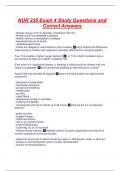
-
NUR 235 Exam 4 Study Questions and Correct Answers
- Exam (elaborations) • 18 pages • 2024
-
- $9.99
- + learn more
Shorter airway (4 mm in diameter compared to 20 mm) - flexible larynx is susceptible to spasms - flexible trachea is susceptible to collapse - decreased amount of alveoli - underdeveloped lungs - infants are obligatory nose breathers (until 4 weeks) which anatomical differences make caring for children with respiratory disorders different than caring for adults? True. This creates a higher oxygen demand. t or f? An infant's metabolic rate is almost twice as high as an adult's metabolic rate. ...

Study stress? For sellers on Stuvia, these are actually golden times. KA-CHING! Earn from your study resources too and start uploading now. Discover all about earning on Stuvia


